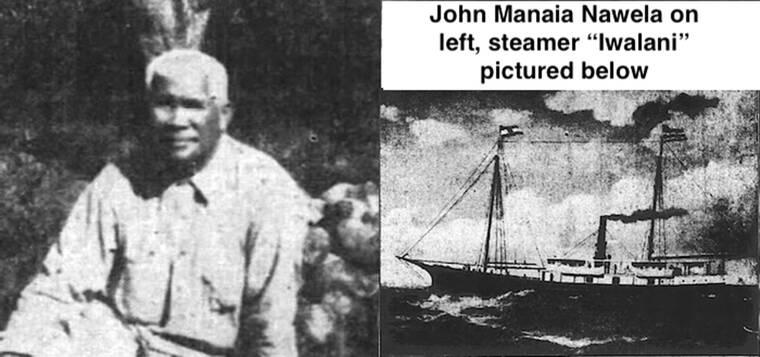Born at Laie, O‘ahu, Native Hawaiian John Manaia Nawela (1852-1940) sailed the Pacific for many years as a whaler and expert harpooner.
He first went to sea in 1874 at the age of 22 on the three-mast, 2,000-ton whaler “Kioki P. Ka,” which was equipped to make voyages lasting two years in the Pacific. He made two long journeys aboard her.
On the first of these voyages, he visited Alaska, Japan and the coast of California. His second trip was made to the Antarctic.
When his whaling days were over, he continued to follow the sea in the Hawaiian Islands on inter-island schooners and steamers, such as the ‘Mikahala” and “Pele,” and eventually was promoted to first mate of the “Iwalani.”
In 1885, Nawela was at sea aboard the schooner “Pohiki” bound for Honolulu from Hilo, when a raging storm sank the schooner off the Big Island’s Puna Coast.
There were no survivors except Nawela, Kekai and First Mate Hoa.
Nawela and Kekai had managed to right a capsized lifeboat and pull Hoa aboard with them.
The three sailors had then clung to life in rough seas for two days and nights, when Nawela recalled his mother telling him long ago of the shark that was their family akua.
Desperately he shouted “Mano au makua o ke kai!” (Oh, aged shark father of mine!) and he began to pray.
Suddenly, according to Nawela, a huge shark lifted the lifeboat, carried it on its back, and gently deposited it upon the beach at Naawaawa on the Big Island.
And, until the day he died in July 1940, Nawela held firm to his conviction that the old gods of the Hawaiian people look after their own.
Finally, in 1919, at the age of 67, he gave up his seafaring life and moved with his family to Kaua‘i to work for the county.
But, misfortune came his way shortly thereafter when he was blinded by an accidental discharge of powder and was pensioned.
In his old age, he lived on Kaua‘i with his foster sons, Stanley Oana and William Keau of Lihu‘e.
•••
Editor’s note: Sailor Kekai and First Mate Hoa’s first names were not found in research. Author Hank Soboleski indicated that often many Hawaiians were known only by one name.



what a beautiful story, chicken skin kine